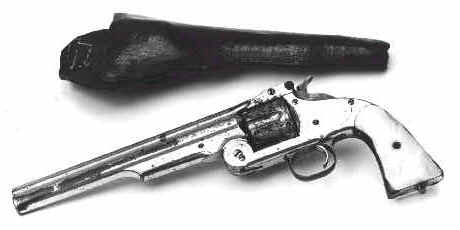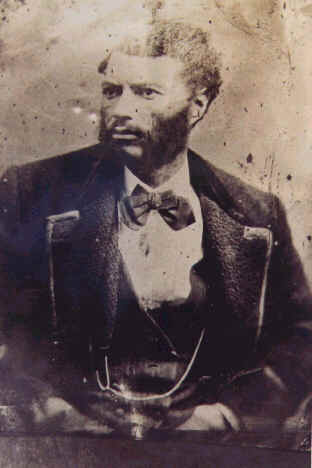Welcome to Lee County, Arkansas
The Gun That Talked
by Chris Hirsch
To many antique gun collectors a piece that shows honest, period use can be an inspiration for a vivid imagination. Many times we have made a comment such as, "If it could only talk, the stories this gun could tell!" This article is about a revolver that came very close to actually talking.
In the early 1980’s I began a quest to find a reasonable example of each large-bore, single action cartridge revolver used during the 1870 – 1898 period of the American west. This task seemed easy enough until the variety of models and manufacturers became apparent. So, the goal was changed to one piece from each company and some variations of models. Some guns were easy to find and others presented quite a challenge especially since the search was limited to local shops and gun shows. Though some very interesting pieces were obtained, there is one that stands out historically above all the others.
At some early point in my adventure a fine Smith & Wesson No. 3 first model showed up on a table at the Houston Gun Collectors Association gun show. It had about 80% of the original nickel finish and very nicely aged ivory grips. Also included was a plain holster that had obviously been with the revolver for ages. The price was reasonable but still a bit high for a struggling gunsmith’s limited budget. The gun sat at the show for all three days and did not sell. This was before the great popularity of western pieces known today. I left the show and the ‘Smith’ thinking the right thing had been done but could not forget about it. A few days passed and the decision was made to call the owner of the gun and have it shipped to me. After working the deal he told me, "By the way, this old gun belonged to a black sheriff here in Arkansas." This is where the old pistol started to talk.
This seemed a bit unusual that such a staunch southern state would have a black sheriff back when this gun was being sold (1871 – 1874). After asking for the sheriff’s name I was informed that there was no way to find out because the court house burned on more than one occasion destroying all of the records. This began to really bother me so I called again and asked for the county and county seat that the sheriff worked. Marianna, Lee County was the answer. The sheriff’s dept. was called but they knew nothing of any black sheriff and recommended calling the courthouse. A clerk answered at the courthouse and I told her my story. Her answer was quick and not to be forgotten, "Oh, there’s only been one black sheriff in this county and that was in 1874. His name was W. N. Furbush." I had the man!
At first I was more interested in trying to verify Furbush’s ownership of the gun. The fact that the pistol was not represented to me as a historic piece discounts the notion that the story was fabricated to enhance the sale. After further inquiries were made as to the source from which the gun was obtained it was revealed that an old time local gun collector, who was a barber, had obtained the gun from a family member. I then asked a local historian about any gun collectors in town that might be able to help in the matter and was informed that the only known, serious collector was dead and he had been a barber. This was enough for me to have faith in the story. After many, many hours on the telephone a very intriguing story of political manipulation and racial tension during the later reconstruction period in Arkansas began to unfold.
The actual name of our subject turned out to be W. Hines Furbush. His story is quite involved and rather lengthy so this will be a somewhat abbreviated account. Furbush was reported in 1873 to have been a red-haired Mulatto with a great deal of influence with the black population of the newly created Lee County (named after R. E. Lee), Arkansas. He was a representative from Phillips County and played a major role in creating Lee County. The democrats were in jeopardy of losing some vital positions in the first elections of Lee County. They assured Furbush if he would ride the country using his influence to get the black voters to vote for the democrats, he would be appointed sheriff. This he did after which he held the position of Lee Counties first sheriff. This certainly did not rest well with some of the staunch southerners that less than a decade earlier were fighting for their rights as slave holders. This fact was demonstrated at a meeting in the Town Square of Marianna when a man in a black robe and hood stabbed the sheriff in the back. Furbush spun around asking loudly, "Who in the hell stabbed me?" A man standing near pointed and declared, "There he goes, that man in black!" Furbush fired at the man hitting him in the head, killing him. This mans name was Tom Wood and his descendants are still living in the area.
It seems that Mr. Furbush was easily manipulated by the white community in the beginning, but reports show that he may have begun to take the office of sheriff a bit too seriously. After speaking to an elderly ex-sheriff of Lee County it became clear that Furbush’s position as sheriff and his life may have come to a violent and sudden end. This ex-sheriff declined to give details but stated that, when he was a young man, he knew a man that stated to him that he, ‘killed Furbush on the railroad tracks’. This corresponds with reports that Furbush’s term of office had come to an ‘abrupt end’.
This story evolved into a tale one might expect to see depicted on a television movie or mini-series rather than an actual account. Whether or not one chooses to accept the probability that this hair-triggered Smith & Wesson revolver was the one that dispatched the hooded knife wielder, Tom Wood, or was carried in the line of duty by Lee County’s first and only black sheriff, the story of W. Hines Furbush is real and depicts a turbulent era in American history.
W. Hines Furbush


